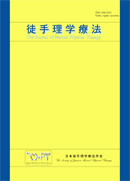Volume 21, Issue 2
Displaying 1-8 of 8 articles from this issue
- |<
- <
- 1
- >
- >|
-
2021Volume 21Issue 2 Pages 35-
Published: 2021
Released on J-STAGE: November 11, 2021
Download PDF (120K)
-
2021Volume 21Issue 2 Pages 37-44
Published: 2021
Released on J-STAGE: November 11, 2021
Download PDF (512K)
-
2021Volume 21Issue 2 Pages 45-49
Published: 2021
Released on J-STAGE: November 11, 2021
Download PDF (350K)
-
2021Volume 21Issue 2 Pages 51-55
Published: 2021
Released on J-STAGE: November 11, 2021
Download PDF (382K)
-
2021Volume 21Issue 2 Pages 57-62
Published: 2021
Released on J-STAGE: November 11, 2021
Download PDF (620K) -
Single case study applying Mechanical Diagnosis and Therapy (MDT) to assess and manage shoulder pain2021Volume 21Issue 2 Pages 63-68
Published: 2021
Released on J-STAGE: November 11, 2021
Download PDF (879K)
-
2021Volume 21Issue 2 Pages 69-71
Published: 2021
Released on J-STAGE: November 11, 2021
Download PDF (294K) -
2021Volume 21Issue 2 Pages 73-77
Published: 2021
Released on J-STAGE: November 11, 2021
Download PDF (1426K)
- |<
- <
- 1
- >
- >|
